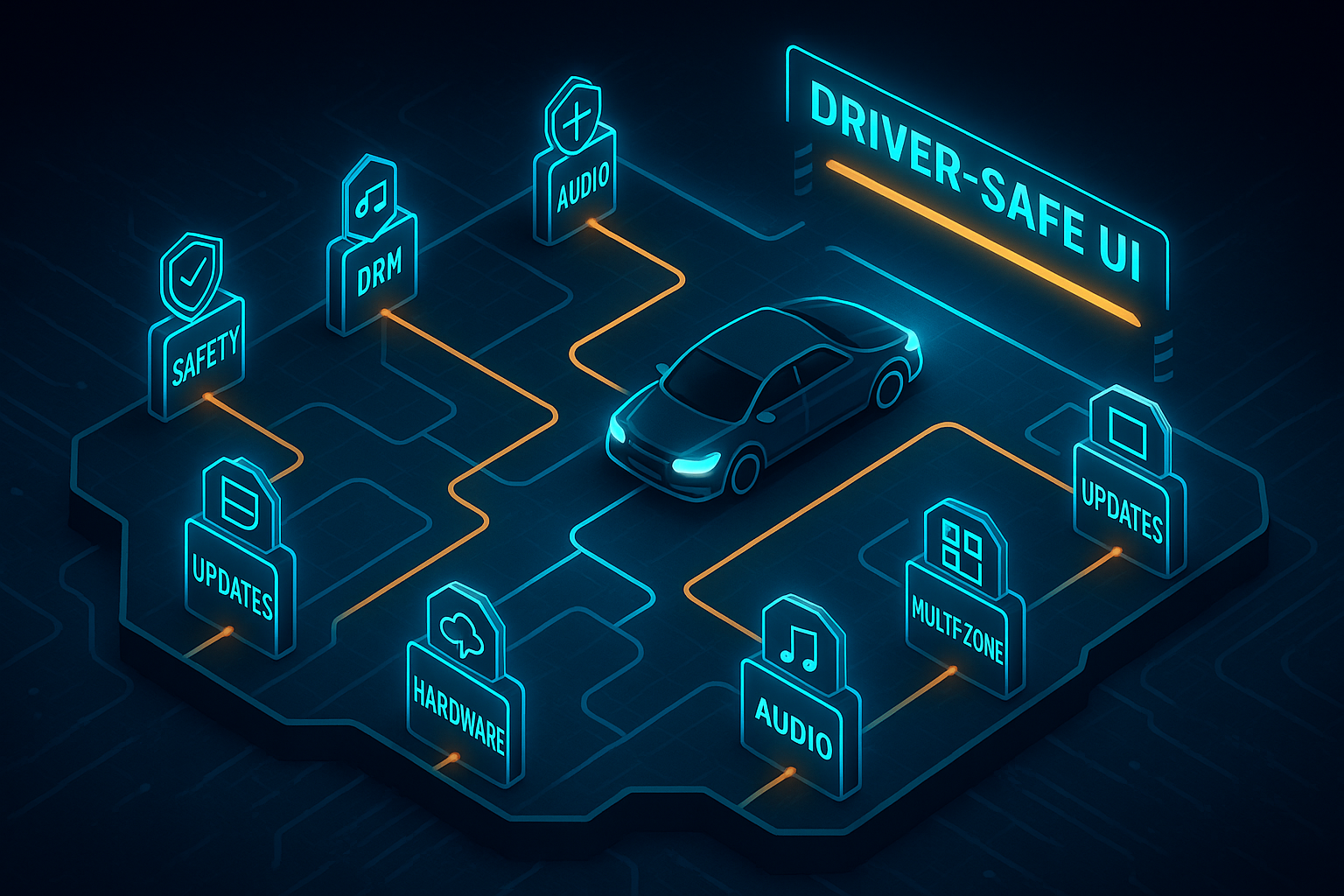Challenges in AAOS Media Playback App Development
Developing media playback apps for Android Automotive OS (AAOS) opens exciting opportunities but also comes with challenges very different from mobile Android. Unlike smartphones, the in-car environment is safety-first and driver-centric, demanding strict compliance with Google’s framework and OEM-specific integrations. Below are the key challenges faced by both OEMs and third-party developers.

Developing media playback apps for Android Automotive OS (AAOS) opens exciting opportunities but also comes with challenges very different from mobile Android. Unlike smartphones, the in-car environment is safety-first and driver-centric, demanding strict compliance with Google’s framework and OEM-specific integrations. Below are the key challenges faced by both OEMs and third-party developers.
1. Strict Framework Rules
Media apps on AAOS must comply with MediaSession and MediaBrowserService APIs. Developers need to restructure apps to expose their media library through these services, often requiring major refactoring compared to Linux/QNX systems. Customization is limited, certification failures are frequent, and aligning mobile-first Android APIs with automotive use cases remains a challenge.
2. Audio & Hardware Complexity
Car audio systems involve multiple speakers, DSPs, external tuners, and chimes for alerts (seatbelt, indicators). Apps must gracefully handle audio focus changes, routing policies, and interruptions triggered by the vehicle. Proprietary OEM DSP tuning adds more variability, making robust audio management essential.
3. CarMediaApp & UI Restrictions
App developers don’t build a full UI; instead, they supply content and metadata to the CarMediaApp, which renders a driver-safe interface using predefined templates. While this ensures safety, it limits branding, advanced features, and deep navigation models. OEMs also face restrictions when trying to differentiate the UX.
4. CarMediaService Limitations
CarMediaService, part of the AAOS build, manages source switching and playback states. OEMs can extend it, but customizations often break during Android upgrades. Timing issues in source switching are particularly difficult to debug and resolve.
5. Video Playback Restrictions
Video support is heavily restricted for safety. CarMediaApp does not support video by default; OEMs must build compliant apps that only work in parked mode. Even then, hardware limitations, DRM enforcement, and template-driven UIs reduce flexibility.
6. Version Updates & Security
Each OS release requires OEMs to validate compatibility of their custom player and libraries. Outdated codecs or frameworks are frequent security risks, but patching is complex in automotive where products have long lifecycles.
7. Content Protection & DRM
Premium content demands strict DRM enforcement (Widevine, PlayReady, etc.). Developers must handle secure pipelines on low-power hardware, passenger-only playback restrictions, regional rules, and OEM certifications—all of which often require multiple DRM integrations and fallback strategies.
8. Advanced Audio Features (Dolby, Multi-Zone, Zones)
Integrating advanced features like Dolby Atmos, multi-zone playback, or concurrent audio streams is a major pain point. Support varies widely by OEM and hardware, requiring fallback audio paths, extensive testing, and certification. Latency, routing conflicts, or quality drops are common in multi-zone playback scenarios.
9. Multi-Display Support
While AAOS supports the primary infotainment screen, rear-seat or passenger displays are OEM-defined. This creates fragmentation. Some cars allow synchronized playback across multiple displays, while others block or downgrade streams. Developers must often adapt to OEM-specific multi-display frameworks.
10. Multi-User Handling
Multiple driver/passenger profiles introduce added complexity. Issues like session resets, DRM license drops, and account persistence failures often occur when switching users. Privacy and subscription management must be carefully handled within limited in-car storage.
Bottom Line
AAOS media playback app development is not just about building an Android app. It’s about navigating strict safety guidelines, OEM customizations, hardware quirks, and evolving standards. Success requires deep collaboration with OEMs, rigorous testing across hardware variants, and constant vigilance on security and DRM. For developers, the biggest challenge is balancing Google’s strict framework compliance with OEM-specific demands, all while ensuring a seamless, distraction-free user experience.
Delivering exceptional infotainment software for the automotive industry
We organize for learning: small, cross-functional teams keep authority close to the work; we make feedback visible and improve in short, honest loops.



.svg)

.svg)

